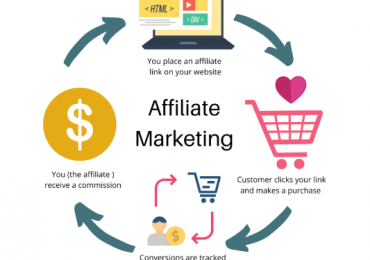
Social media marketing is the process of using different social media sites to market goods and services and build relationships with potential and current customers. This type of marketing relies on the use of social platforms such as Facebook, Instagram, Twitter, LinkedIn, and others to communicate and interact with the target audience.
The beginning: The idea and vision: My journey as a marketer on social media pages began with a simple idea: How can I benefit from social media platforms to reach a wide audience and promote products? The idea was the beginning of a larger vision, related to how to transform this idea into a successful business through which I can make profits.
The first step: Entering the world of social media: I decided to start creating accounts on various social media platforms such as Facebook, Instagram, and Twitter, where things were not easy at first. The challenge was to understand the nature of each platform, according to its audience and the way they interact. I spent a long time researching and learning about the experiences of others, which helped me form a clear idea of how to work on each platform.
Challenges and Difficulties: Penetrating the Market and Getting Attention: One of the biggest challenges I faced was the ability to penetrate the market. The market was full of competitors with a large audience, and it was difficult to attract attention to the content I provided. It was not only about creating good content, but also knowing how to promote it correctly and at the right time. I dealt with difficulties in determining the best times to publish content, and I discovered that timing plays a big role in increasing engagement. In addition, there were challenges in continuing to produce distinctive and attractive content on an ongoing basis, as continuity was a challenge in itself, as it required a lot of creativity and hard work to maintain the interest of followers.
Content Creation: Words, Images, and Videos: I realized the importance of content in attracting attention and building a brand. I started experimenting with different types of content: text posts, attractive images, and short videos. Videos were one of the most important means I used to deliver the message quickly and attractively. I learned how to shoot and edit videos, and I chose topics that interest the target audience.
Social Media Trading: A new experience as I started trading by displaying and promoting products. I discovered that there was a need to develop strategies specific to each product and a different promotion method depending on the nature of the audience and the product. I used analytics to understand audience interaction and improve the display and marketing method.
Attraction and audience building: I realized that success on social media platforms depends largely on the ability to attract and build an audience. I organized competitions, offered free gifts, and continuously interacted with followers. Personal interaction with followers was one of the things that helped me build a community around the brand.
Lessons learned from strategies:
- Adapting to changes: Social media platforms are constantly changing, so it was important to keep up with these changes and update strategies constantly.
- Trial and error: Not everything I tried was successful, but every experience was a lesson. Failure may be the way to learn and develop.
- Personal communication: Building a strong relationship with followers through personal communication that contributes to enhancing trust and loyalty to the brand.
- Content diversity: Relying on one type of content may lead to loss of interest. Content diversity attracts a wider audience and maintains their interest.
Steps to launch an effective promotional campaign on Facebook
1. Idea and content writing:
- Determine the goal: Determine the goal of the post, such as increasing sales or promoting a new product.
- Write the content: Make the content simple and attractive with a clear call to action. Use a high-quality image or video.
- Create the post.
2. Log in to Facebook Business: Create a new campaign via Facebook Business](https://business.facebook.com/).
- Choose the goal: Choose the campaign goal, such as "engagement" or "conversions".
- Determine the target audience: Determine the audience based on location, age, and interests.
- Determine the geographic location: Choose the area you want to target.
3. Budget and scheduling settings:
- Determine the budget: Choose a daily or total budget for the campaign.
- Scheduling: Set the start and end date for the campaign.
4. Set up payment:
- Payment methods: Add the appropriate payment method and verify its validity.
5. Publish the post and follow up on the results:
- Review the campaign: Make sure the settings are correct before publishing.
- Publish the campaign: Click "Publish" to activate the campaign.
- Monitor performance: Use Facebook's analytics tools to monitor performance and adjust the campaign if necessary.
6. Analyzing the results:
- Data analysis: Analyze the results after the campaign ends to identify strengths and weaknesses.
- Lessons learned: Draw lessons to improve future campaigns.
Previous example applied
• Facebook promotional campaign: Remote control plane
- Idea and content: The campaign started with the idea of targeting RC plane enthusiasts, children, and parents looking for a unique gift for their children. The promotional text was: "Make your adventures in the sky a reality! Discover our new remote control plane, and enjoy an unparalleled flying experience." The text was accompanied by a carefully designed video, showing the plane in flight, with impressive shots showing its maneuverability and ease of control. The video was accompanied by exciting music to attract attention and highlight the enjoyable flying experience offered by the plane.
- Campaign Setup: Facebook Business was used to set up the campaign, where the “Conversions” objective was chosen, which focuses on getting users to take a specific action, such as purchasing or registering. I defined a precise audience using advanced targeting features, such as the age group (18-45 years) and interests related to drones, technology games, and recreational hobbies. I also used geo-targeting for areas that showed the highest interest in such products.
- Budget and Scheduling: A daily budget of $15 was allocated over two weeks. The goal was to reach the largest possible target audience in a short period of time to achieve quick results. The campaign was scheduled to run at times when the audience is most likely to interact with the ads, such as evening hours and weekends.
- Analysis and Learning: After launching the campaign, performance was tracked using Facebook Ads Manager. Analytics showed the level of engagement with the video, the number of conversions, and the click-through rate. Through analysis, it was determined that the ad copy and video were successful in grabbing the audience’s attention and getting them to take the desired action. However, the analysis showed that the audience in the 25-35 age group was the most engaged, which prompted me to adjust the targeting in the middle of the campaign to focus more on this group.
This analysis helped improve the promotion strategy in the future, by focusing on the elements that proved successful and adjusting those that did not achieve the desired performance.
Looking towards the future: My experience in marketing through social media platforms was full of challenges and opportunities. I learned a lot, and I am still learning. I look forward to developing my strategies and continuing to succeed in this dynamic field.
By e-marketing student
Bahaa El-Din Hani Ali Salem

18/08/2024

21/08/2024

21/08/2024

05/09/2024

11/09/2024

12/09/2024

12/09/2024

13/09/2024

26/08/2024

01/09/2024

01/10/2024

18/08/2024

16/08/2024

11/09/2024

11/09/2024

14/09/2024